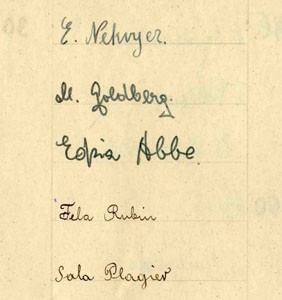
Sara Rachela Plagier
The Jewish children of Lodz suffered unfolding harsh realities after the German invasion of Poland. Some of the children, among them Sara Rachela Plagier, recorded their experiences in diaries. Their voices offer a view into the struggle of a community and its young to live in spite of the most difficult circumstances.
Excerpts
“In the ghetto we had no need for a calendar. Our lives were divided into periods based on the distribution of food: bread every eighth day, the ration once a month Each day fell into two parts: before and after we received our soup. In this way the time passed.” —Sara Plagier, age 14
“One day, little Rysia asked if Jews looked different before the war from the way they looked now and if they ever looked like non Jewish people. After hearing that there is no real difference between non-Jews and Jews, she contemplated this for a moment and finally asked: 'So why do they separate us from them?'”—Sara Plagier, age 15
“Chaim Rumkowski was an absolute monarch. He could banish anyone he wished from the ghetto. He could transfer people from one place to work in another. He could send people to prison. He was all-powerful. Nevertheless, when it came to the Germans, he could do nothing. They could raise their hands or their clubs against him, beat him, kill him. But among us he was the king. We called him by all sorts of titles: 'His Excellency the Chairman,' 'The Eldest of the Jews.' And we called him 'King.'” —Sara Plagier, age 15, ca. 1941-42
“I saw two wagons full of little children drive past the open gate. Many of the children were dressed in their holiday best, the little girls with colored ribbons in their hair. In spite of the soldiers in their midst, the children were shrieking at the top of their lungs. They were calling out for their mothers.”—Sara Plagier, age 16
Sara's Story
Sara Rachela Plagier was born on March 26, 1927, in Lodz, the only daughter of Anszel and Mindl Plagier. Sara's father was a partner in a knitwear factory and religious ornament artist. After the German invasion of Poland, Sara's father wanted his small family to flee to the east, but Sara's mother wouldn't hear of parting from her siblings. After a few months of the occupation they decided to move to Warsaw. They moved all their belongings ahead to Warsaw and they themselves were supposed to travel; however, they were trapped when the Lodz ghetto was sealed.
Sara started to attend the ghetto high school (she is signature # 13,049 in the album). Her mother died in the ghetto at the age of 36 and Sara went to live with her maternal aunt Cesia and five children. After the schools were closed, Sara started to work in a corset sewing workshop. She was 14 years old. During the deportations of the winter and spring of 1942 aunt Cesia and her immediate family were deported to Chelmno and Sara moved in with another aunt. Sara's father was gravely ill and was taken to the hospital. Sara was ordered to come to the ghetto prison for deportation and only by chance was she released. During the Gehsperre Aktion in the Lodz ghetto Sara's beloved aunt Hanusia was taken away, but she and her father managed to hide in an abandoned house. During Passover 1943, Sara's father succumbed to hunger and died. In August 1944, Sara was deported to Auschwitz-Birkenau. She was later transferred to Mittelstein forced-labor camp.
She was liberated by the Red Army and after barely avoiding being raped by a drunken Russian soldier, Sara and a few survivor girlfriends managed to return to Lodz. She met and married fellow Lodz survivor Eliezer Zyskind. The couple immigrated to Israel. They had three children. Sara Zyskind described her experiences in a book, Stolen Years. She died in 1995.
Critical Thinking Questions
- Why are diaries an important part of the historical record?
- What makes children’s diaries distinct?
- How are some of these accounts different from that of Anne Frank?
- Investigate the experiences of children in the ghettos.

